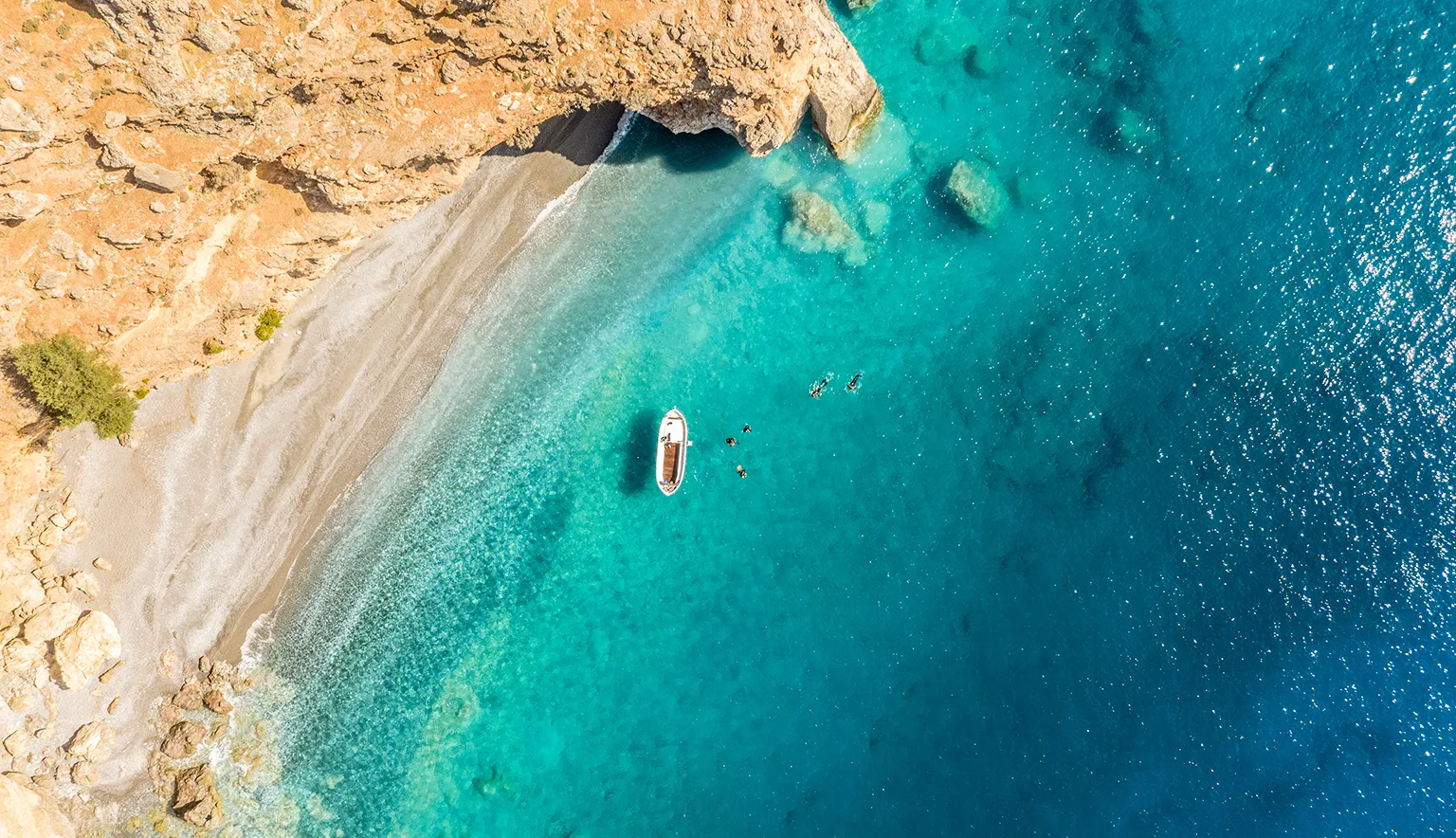Authentic cuisine, restorative experiences, and a white and pink powdered coastline are why Crete should feature on every island itinerary. The shimmering, peacock-coloured waters and rugged terrain cast an enchantment which illuminates its myths and unveils a treasure trove of history in this cradle of European culture.
INTRODUCTION
As the largest island in Greece, Crete offers myriad adventures for visitors, with remnants of ancient civilisations waiting to be admired against the backdrop of impressive mountainscapes and steep gorges concealing waterfalls.
Fertile valleys are juxtaposed with palm trees and blue seas, whilst rich gastronomy will entice visitors into the many traditional tavernas that populate the vibrant cities, picturesque towns, and charming villages.
Beyond its beautiful beaches, Crete’s diverse topography encompasses Dikteon Cave, said to be the birthplace of “Xenios” Zeus, the god of hospitality. Its majestic stalactites and stalagmites make the climb up the mountain worthwhile, as on the ascent, travellers are rewarded with dramatic views of the Lassithi Plateau.
Full of tradition and with a generous spirit, Cretan culture permeates the entire island. Centred here during the Bronze Age was the Minoan civilisation, so called after the mythical king of Crete, Minos, whose labyrinth housed a Minotaur and was built by Daedalus – a skilful architect and craftsman in Greek mythology and the name given to complex structures to this day.
Renowned for its architecture and art, the mighty Minoan legacy is evident in the fresco-decorated palaces of Knossos and Phaistos, two unmissable attractions and the most famous Minoan palaces. The palaces of Malia, Zakros, the winter palace of Zominthos, and the site of ancient Kydonia, meanwhile, are nominated for their serial inscription on the UNESCO World Heritage List.
The island’s heritage is also deeply rooted in its cuisine, with the Cretan diet considered a philosophy for life. Internationally renowned for unique ingredients and flavours, it relies heavily on locally sourced produce such as olive oil, herbs, and vegetables.
From fruit trees to mountain greens, the island’s distinguished dishes are served in traditional tavernas, and with over 4,000 years of wine-making history, there is an abundance of high-quality krasi to accompany dakos – the signature Cretan salad comprising barley rusk, fresh tomatoes, and its main feature, local cheese drizzled with extra virgin olive oil, complemented by oregano.
From adventure-seeking to nature exploration, whether indulging in culture or sampling local cuisine, every inch of the island offers an intoxicating aroma. Famous for its hospitality and vitality, Crete comprises storytellers and artisans weaving a tapestry of traditions, making it a place that truly nourishes the soul.

Q&A WITH REGION OF CRETE
The Region of Crete is a self-governing authority in Greece dedicated to promoting tourism across the island. We speak with Vice Governor, Dr Kyriakos Kotsoglou, who shares valuable insights about why Crete is a top destination amongst the Greek islands.
Firstly, can you talk us through the origins of the Region of Crete and its initial vision and mission?
Dr Kyriakos Kotsoglou, Vice Governor for Tourism (DKK): Crete is the cradle of Western European civilisation, home to the pioneering Minoan civilisation. Gracefully situated in the Eastern Mediterranean at the crossroads of Europe, Asia, and Africa, Crete has been the arena of many different civilisations throughout history, including Greek, Roman, Byzantine, Saracenic, Ottoman, and Venetian.
This rich history has ingrained hospitality into Cretan DNA. Not coincidentally, Crete was the homeland of Zeus and, amongst others, the protector of visitors.
Travellers from the 18th and 19th centuries described the island’s hospitality as remarkable, as families of the village or community would gather food, always six or seven kinds, to offer to their guests as a token of gratitude. Besides fruit, meals included various meats, poultry, game, or fish cooked and served in diverse dishes, with families often depriving themselves to provide the best for their guests.
Such celebrations allowed Cretans to showcase their products to visitors and, at the same time, express their deep pride. These ‘symposiums’ are rooted in a profound tradition of hospitality, unlike anything found in Western standards.
This is our origin, and our vision is for Crete to remain an authentic haven of hospitality. Our mission is for visitors to become immersed in golden pages of experiences and hospitality that transcend a mere stay, providing a timeless experience.

Why should anyone visit Crete, and what type of travellers does it appeal to? How does it differ from other Greek islands?
DKK: The difference between Crete and the other wonderful islands of the Aegean or the Mediterranean is its incredible diversity. From the celebrity of the 5-star north to the alternative of the hippie south and alpine skiing in the mountains, Crete is a model of diversity that enchants every visitor.
Why is Crete a must-see destination? A common question, yet the answer is simple – it offers a unique blend of three distinct personalities. The north boasts a cosmopolitan atmosphere with a thriving hotel industry, including 30 percent of Greece’s 5-star hotels. However, it also caters to all budgets, offering a wide range of accommodation options.
The charming south, meanwhile, exudes a lovely, alternative vibe filled with stories, hidden paths, and stunning beaches where the sunset and the sea seamlessly merge and the island’s interior reveals a wealth of surprises, from picturesque villages to unspoiled mountains, trails, caves, and waterfalls.
“We are committed to promoting renewable energy sources without compromising the visitor experience. Additionally, we strive to achieve complete recycling, improve our infrastructure, and encourage alternative forms of tourism”
Dr Kyriakos Kotsoglou, Vice Governor for Tourism, Region of Crete
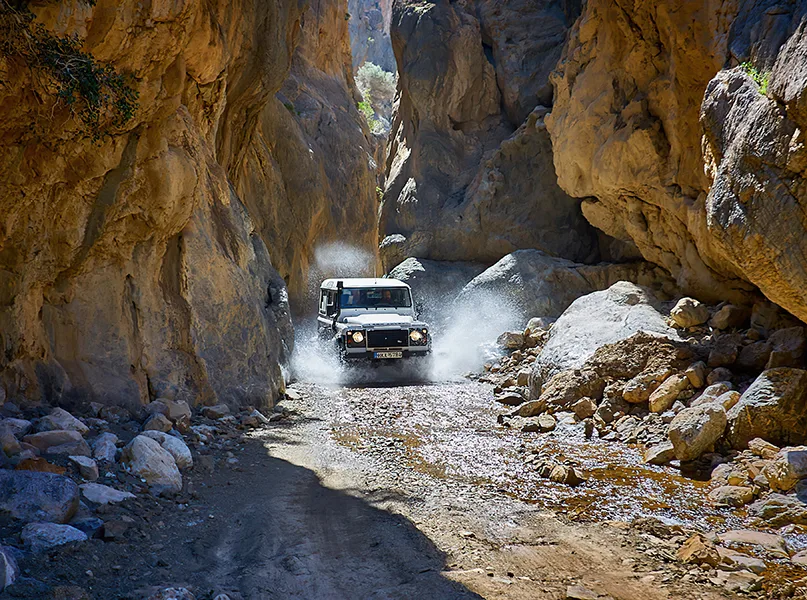
How is Crete embracing sustainable or environmentally-friendly travel experiences?
DKK: This is a universal question that travellers ask about destinations around the world.
Crete’s unique appeal lies in its incredible diversity. The island’s size allows for moments of solitude, whether seeking a secluded beach, a peaceful hike, or a breathtaking view undisturbed by crowds. However, several world-renowned areas, primarily beaches and attractions, contribute significantly to Crete’s reputation and attract substantial tourist traffic.
Notable examples include the renowned beaches of Balos, Falasarna, Elafonissos, and Preveli in Western Crete and Hersonissos, Malia, and Vai to the east of the island. Additionally, our picturesque Venetian ports are major attractions. We are committed to preserving the authenticity of these destinations and ensuring that travellers who honour us with their presence have a truly enriching experience.
We are committed to promoting renewable energy sources without compromising the visitor experience. Additionally, we strive to achieve complete recycling, improve our infrastructure, and encourage alternative forms of tourism.
From the iconic Samaria Gorge to the stunning Richtis Waterfall in Sitia, Crete offers amazing trails, majestic mountains, and a wealth of natural wonders where sustainability and environmental protection are synonymous with nature, and people respect that.

How do you market the island as a destination? What strategies do you employ to promote the off-peak season?
DKK: We’re actively participating in Outlook Travel Magazine and encouraging local businesses and organisations to join us, which is a great opportunity.
Furthermore, our extensive tourism promotion programme includes participation in numerous international travel exhibitions, workshops, and roadshows – totalling over 40 events annually. We also host a significant number of journalists, travel agents, social media influencers, YouTubers, TikTokers, tourism influencers, and tourism thought leaders. Our publications are renowned, and we maintain strong partnerships with airlines.
Crete’s global fame is undeniable. Even without extensive marketing efforts, from local publications to renowned international channels like National Geographic, Crete is widely recognised as one of the most famous islands in the world – Crete is everywhere!
Often referred to as ‘The Little Continent’, Crete bestows countless reason to visit, but four key pillars stand out: our unsurpassed nature, gastronomy, culture, and heartfelt hospitality.
Crete offers a year-round experience, with something to discover every month. We promote this concept as ‘12 Reasons – Months to Love Crete’. However, Crete is an island, and airlines must support our tourism efforts. We’re waiting for you, and we invite you to discover the beauty of Crete during the off-season when nature flourishes, culture thrives, cuisine is at its peak, and hospitality is personalised.
“Often referred to as ‘The Little Continent’, Crete bestows countless reason to visit, but four key pillars stand out: our unsurpassed nature, gastronomy, culture, and heartfelt hospitality”
Dr Kyriakos Kotsoglou, Vice Governor for Tourism, Region of Crete

Are there any interesting or exciting projects you would like to highlight?
DKK: Unlike many other destinations around the world, where landmarks, often referred to as monuments or toponyms, are primarily man-made structures like Big Ben, the Brandenburg Gate, and the Colosseum, Crete’s most iconic features are its stunning natural formations, which require careful preservation to ensure their enduring beauty.
Crete’s infrastructure requires modernisation and improvement. Kastelli International Airport, expected to be operational by early 2027, will address the limitations experienced at existing airports. Additionally, completion of the new Northern Motorway will enhance transportation and safety.
We are also committed to implementing biological cleaning at our marinas and ensuring equal accessibility for individuals with disabilities. These initiatives are part of our comprehensive plan to modernise Crete’s infrastructure and create a holistic and welcoming location.
What trends are transforming the tourism industry on the island, and how are you utilising them?
DKK: Today’s travellers are seeking more than just a place to stay; they crave immersive experiences that align with sustainable practices and digital advancements, which are key trends shaping the future of tourism.
In response, Crete has strategically linked its UNESCO World Heritage Sites – the White Mountains and Samaria Gorge, Psiloritis Natural Park, Asterousia Mountains, and Sitia Geopark. We believe that visitors are now ready to embrace the beauty and diversity of Cretan nature fully, enjoy hiking the E4 European long-distance path, and truly immerse themselves in every experience.
Furthermore, in the developed areas in the north of the island, we are working with businesses to implement eco-friendly practices and combat greenwashing – a negative trend in the tourism industry that, unfortunately, has gained traction.
The green transition and digital transformation are crucial for Crete’s sustainable tourism journey, which will preserve the island’s authenticity and allow visitors to “Sense the Authentic”, as highlighted in our global campaign. Join us on our digital transformation journey by visiting www.incrediblecrete.gr and exploring Crete’s diverse experiences.

What challenges does the tourism industry in Crete face, and how do you navigate them?
DKK: Crete, as an island and a region, is fortunate to see its visitor numbers grow annually. It does not show signs of overtourism, however, our concern is to ensure it never does. Crete needs to strike the right balance between developing its infrastructure and preserving the unique qualities that make it a popular destination.
On the other hand, it’s essential for Crete to verify the sustainability of its natural resources, and we have comprehensive plans in place to manage water resources effectively and avoid shortages. However, challenges related to infrastructure, such as drains, sidewalks, and public spaces, need to be addressed, especially in the context of climate change, which we believe can be viewed as an opportunity to revitalise tourism during the shoulder months, for it is then that Crete is truly exciting, sustainable, and authentic.
What is the Region of Crete’s current goals and key priorities for the coming year?
DKK: The COVID-19 pandemic made us wonder whether Crete is truly an incredible destination or a marketing product. In 2020, arrivals dropped to 27 percent below pre-pandemic levels. However, Crete’s performance was remarkably resilient compared to other destinations that experienced near-total declines.
In 2021, Crete recovered 75 percent of its 2019 visitor numbers, demonstrating the significance of its diverse tourism offerings and capacity to accommodate visitors in inland areas. This success was evident in articles praising Crete with the title ‘Quarantine in Paradise’.
Since then, Crete has witnessed a steady increase in arrivals, surpassing pre-pandemic levels by 6.5 percent in 2022 and maintaining a growth rate of six to seven percent annually. While global inflation poses challenges, Crete’s tourism industry is poised for further growth, supported by Kastelli International Airport and the Northern Motorway. However, our top priority is to manage the increase in visitors sustainably.
Our goal to maintain Crete’s reputation as a popular destination and establish a reputation for our commitment to authenticity.

Are you optimistic about the future of tourism in Crete? How do you see it developing in the years ahead?
DKK: We have unwavering optimism regarding tourism in Crete – we wouldn’t be in this position if we didn’t. The consistent increase in arrivals fuels our positivity, and we are committed to preserving the unique qualities that make Crete famous, faster, farther, and stronger – “citius, altius, fortius”.
To maintain our success, we must always view things from the perspective of our visitors, not solely from our own. This is the biggest secret to establish successful hospitality and service in general, and in Crete, we know this very well.
Reaching the top is challenging, but staying there requires even greater effort without negatively impacting the visitor experience and the quality of life for our residents.
Sustainable tourism is not only about the visitor and their vacation, but also the harmonious symbiosis between visitors and locals regarding equality and a considerate relationship between host and visitor, as is now the case in Crete. Otherwise, it’s your paradise, my misery!
OUTLOOK RECOMMENDS
Eat:
FOR AN UNFORGETTABLE VISTA…
Lyrarakis Winery and Tasting Room offers a beautiful lunch setting, nestled among the Psarades vineyard and the Lassithi Plateau. Guests can embrace the spirit of Dionysus, the god of wine and pleasure. The winery features rare indigenous grapes that produce three ancient Cretan wine varieties, which visitors can enjoy in a peaceful area under the shade of olive trees, complemented by a picnic basket filled with premium Cretan cheeses and other traditional delicacies.
FOR UNADULTERATED ELEGANCE…
Prima Plora uses raw ingredients to explore Cretan cuisine free from pesticides and fertilisers, utilising animals fed by nature. Indulge in sushi, salads, steak, seafood dishes, fresh bread, and olive oil while enjoying a relaxing, luxurious oceanfront atmosphere.

Do:
FOR A SERENE SAILING EXPERIENCE…
Set Sails invites visitors to board its sumptuous sailing boat and enjoy the spellbinding cityscape of Heraklion, the administrative capital of Crete.
Set Sails’ fresh Mediterranean lunch of flavoursome Greek salad, renowned seafood pasta (alternative options are available), and fruits are included in the package along with beverages including wine, beer, water, and soft drinks.
The professional captain and crew can accommodate up to eight people per boat on a six-hour sailing trip, sailing to Dia, a small, uninhabited island known for its natural beauty and abundant marine life where guests will have the opportunity to use snorkelling equipment and explore its thrilling depths. If going underwater isn’t for you, paddle boarding is also an increasingly popular option.
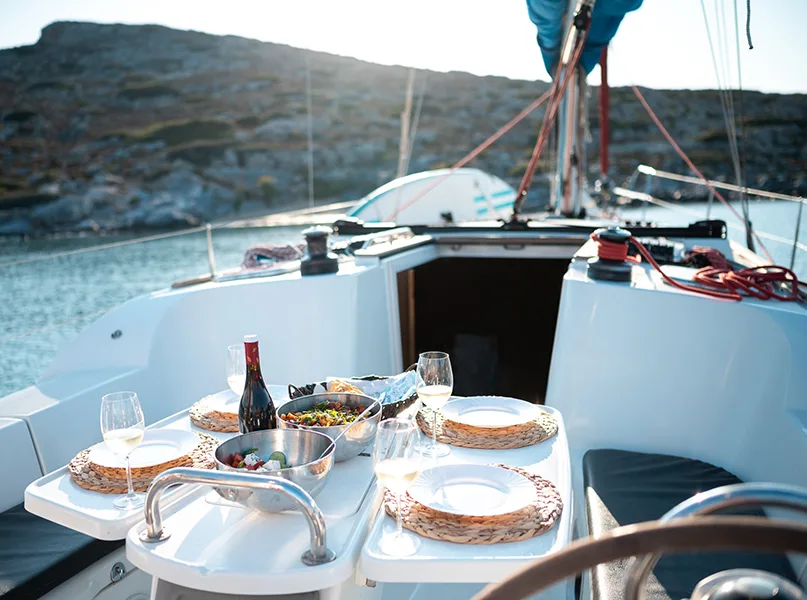
Filled with mystery, mythology, and history, there are various ways to experience the beauty of Dia. Take a morning trip as the Cretan sun gathers its strength, the crystal-clear waters shimmer, the sweet smell of the Mediterranean breeze gently tickles the senses, and the panoramic coastline gives way to dolphins playfully surfacing along the way; the soothing sound of the ocean will both relax and restore as the boat sways. At the same time, sunset sailing creates lasting memories as the return journey unfolds under a twinkling celestial canopy.
Whether relaxing or exploring at sunrise or sunset, Set Sails’ dedicated team can organise minivan transfers to the landscapes of Agia Pelagia, lively coastal resorts, quaint villages, bustling hubs, and historic towns.
FOR FUN AND ENTERTAINMENT…
Music and dancing are synonymous with Greek culture, so it is highly recommended for visitors to immerse themselves in Cretan rhythms. The Pyrrhic is the most famous dance in Crete, although each region has its own traditions, most of which retain the iconic circular pattern, whilst Cretan costumes are vivid and create a stunning display. Other dances include the Pentozali, Sousta, and Pidichtos, performed energetically by couples.
With a lute or violin as guidance, dancers exhibit skill through complex steps, accompanied by the lute and rarer instruments. Cretan music is regarded as the most vibrant in Greece as the melodies are not limited and improvisation is encouraged. The island is steeped in antiquity, strongly influenced by Byzantine music and enriched by the musical culture of the wider Eastern Mediterranean.

Sleep:
FOR A BLISSFUL BREAK…
Aoria Estate has a boutique villa, apartments, and suites in the picturesque Venetian town of Chania near the harbour. Experience Cretan hospitality amongst beautiful scenery and all the amenities for a peaceful and stress-free stay.
FOR A PRIVATE RETREAT…
Elani’s Stately Home is an exceptional villa in the picturesque location of Episkopi village in Rethymno with mountain views, a swimming pool, and 24/7 concierge service. The stone-built beamed house features a mesmerising terrace that glows at night, filled with fragrant florals and flanked by leafy trees that create a sanctuary in the midday sun.
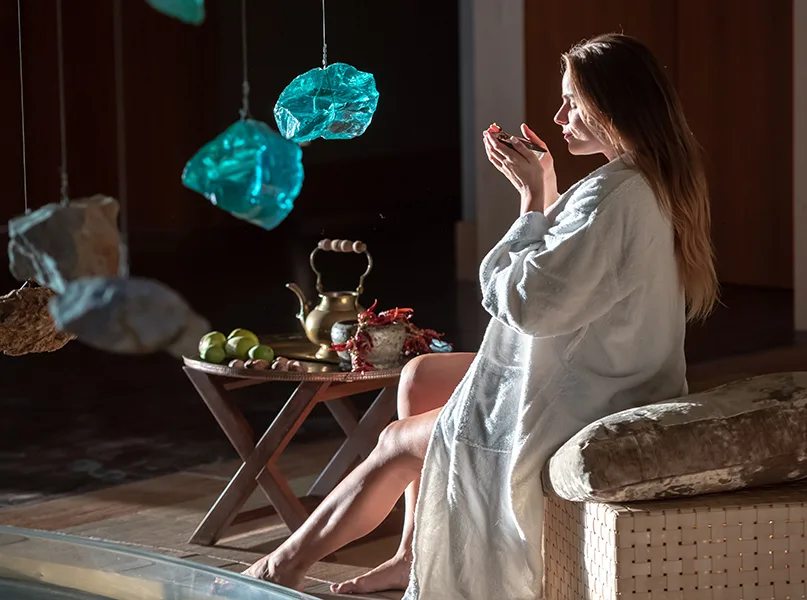
CHANIA IN FOCUS
On the northwest coast of Crete lies Chania, recognisable by its 14th-century Venetian harbour, ready to beguile with its historical grandeur.
The pretty city is crisscrossed by narrow lanes accented by pastel-coloured buildings and old townhouses converted into restaurants and boutiques. The diverse architecture reflects the island’s rich history, showcasing influences from the Ottoman, Venetian, Byzantine, and Egyptian empires. Indeed, the conquests left an indelible mark on Chania’s marine panorama, particularly highlighted by the construction of the Küçük Hasan Pasha Mosque, also known as the Mosque of the Janissaries. Built in 1645, it is the oldest Ottoman structure in Crete.
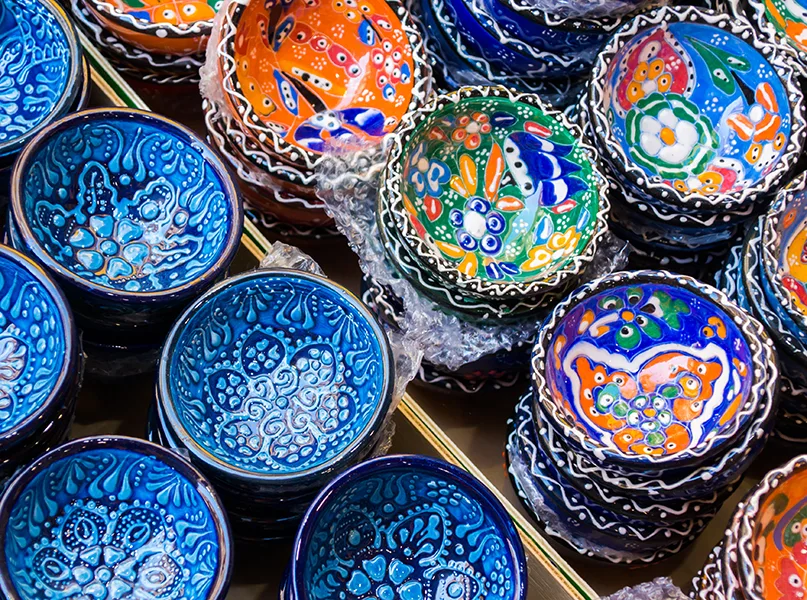
Chania’s charm extends to its beaches, which are amongst the most breathtaking in Greece. The glittering lagoon of beautiful Balos is teeming with flora and fauna endemic to Crete and protected under the Natura 2000 programme. Located on the Gramvousa Peninsula, Balos is also home to migratory birds, the Mediterranean monk seal – which gives birth in the underwater caves – and the loggerhead sea turtle, all of which can be experienced on a boat tour.
The area offers a wide variety of experiences for every type of traveller, from local cuisine and nightlife to historical sites, and hiking through the unique countryside or scenic coastline. A range of beaches provide ample opportunity for snorkelling and scuba diving.
The Old Town features shops with locally made ceramics and jewellery boutiques, and the city is filled with attractions like the Venetian Lighthouse, the Ottoman Baths, the Clock Tower, and the Castle of Gramvoussa. In addition, visitors can explore the Archaeological Museum of Chania and delve into the history of the area.

LANDMARK ATTRACTIONS
ZAKROS GORGE
Also known as the Valley of the Dead, the Zakros Gorge hiking trail is marked by ancient Minoan burial sites situated in caves and along the canyon walls, where the Minoans worshipped the souls of their ancestors. The bone-white rocks are surrounded by vultures soaring above, enhancing the eerie atmosphere of this remarkable and poignant site.
SPINALONGA
At just 85 acres, the islet of Spinalonga has had several incarnations throughout history. Once a Venetian fortress, it was also a refuge for revolutionaries during the Cretan War and an Ottoman settlement during the Turkish occupation. From the early to mid-20th century, it was a leprosarium before being catapulted into popular culture in The Island, authored by Victoria Hislop.

ELAFONISI BEACH
Exotic crystal waters and soft white and pink sand await visitors in this magical place on the southwestern side of Crete. Cedar trees stretch out towards the coastline, and the beach’s distinctive feature is the blush-hued beach created by thousands of shattered seashells. The inviting shallow water connects to other parts of the island, whilst the fluffy sand makes it ideal for escaping the crowds.
GETTING THERE AND AROUND
There are two international airports in Heraklion and Chania, with flights to the island available from many European airports operated by the likes of Aegean Airlines, British Airways, Lufthansa, Norwegian Air, KLM, and easyJet. However, there are no direct flights from the US or Australia.
Alternatively, travel to other Greek islands and catch a connecting flight, or why not take a ferry to enjoy the scenic route of the Aegean Sea Five companies offer 42 ferry routes, with the fastest from Piraeus, Athens to Chania and Crete. Island hopping is also popular with regular ferries from Mykonos, Naxos, Santorini, and other well-known Greek destinations.
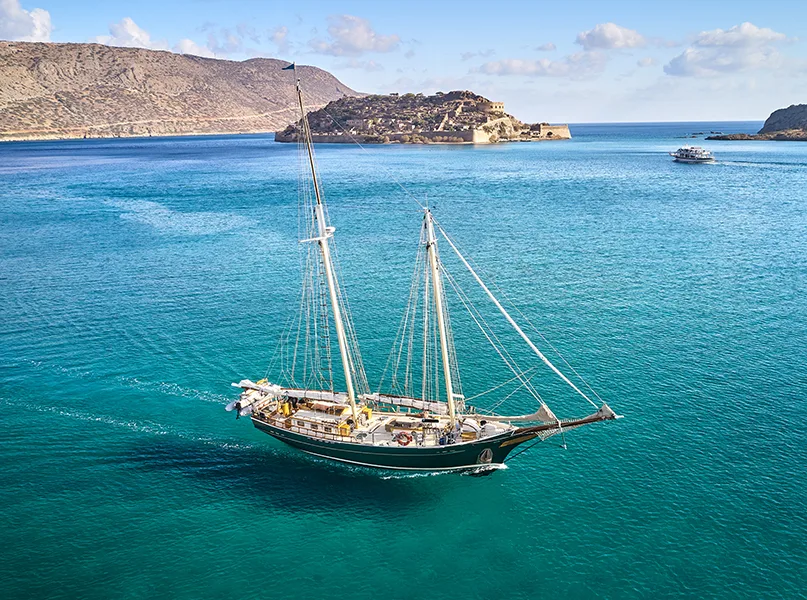
Buses and air-conditioned coaches can take travellers anywhere in Crete, but car rental is just as easy with major vehicle hire brands located in international airports. However, the best deals will be from local companies.
Renting a car may be the best option for travellers with mobility issues, as buses do not have lifts and taxis designed to accommodate people with disabilities are limited to certain areas such as Chania and Iraklio.
Taxis are perfect for local journeys and post-hike pick-ups, while boats connect the idyllic beaches along the southwest coast. For exploring the island, bike rentals are available in larger towns and tourist areas. Prepare for Crete’s hilly terrain and you will be rewarded with a sublime meander through stunning peaks and gorges.


